UK Police Force: Justice, Punishment, and Rehabilitation Analysis
VerifiedAdded on 2022/08/31
|10
|2430
|29
Essay
AI Summary
This essay provides a comprehensive overview of the UK police force's functions, focusing on justice, punishment, and rehabilitation. It delves into the legal framework, including the Police and Justice Act 2006, and examines how the police investigate crimes, consult with the Crown Prosecution Service, and determine charges. The essay explores various aspects of justice, such as the role of regional police forces, the powers of police officers, and the use of restorative justice approaches. It further analyzes different forms of punishment, including cautions, conditional cautions, and penalty notices. Finally, the essay discusses the concept of rehabilitation, examining the roles of probation services and community rehabilitation companies in helping offenders lead crime-free lives. The essay also touches upon the challenges faced by the police, such as the increasing volume of digital information and the costs associated with reoffending, offering insights into the effectiveness of the UK police force's approach to crime and its impact on society.
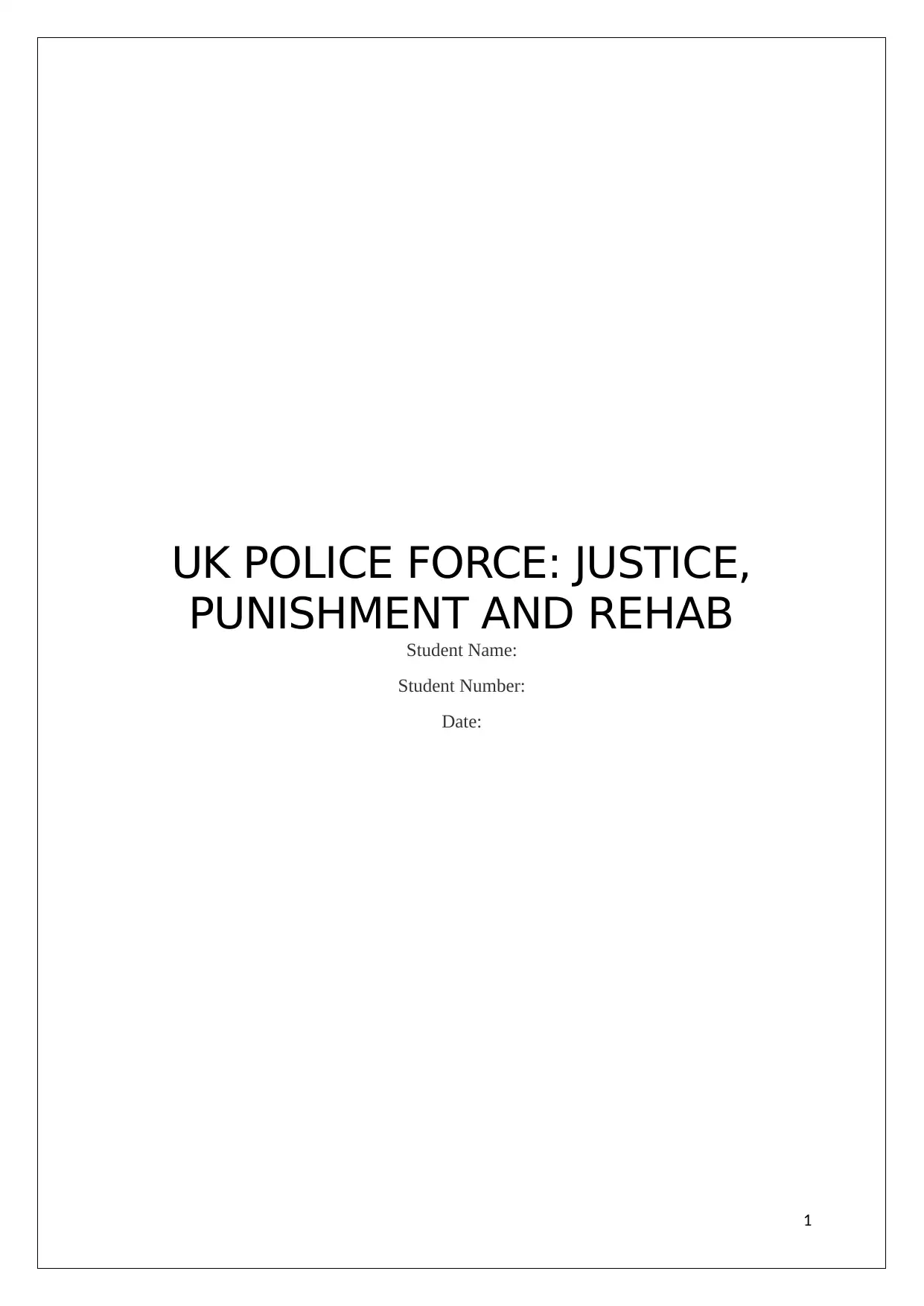
UK POLICE FORCE: JUSTICE,
PUNISHMENT AND REHAB
Student Name:
Student Number:
Date:
1
PUNISHMENT AND REHAB
Student Name:
Student Number:
Date:
1
Paraphrase This Document
Need a fresh take? Get an instant paraphrase of this document with our AI Paraphraser

Table of Contents
1. Introduction.........................................................................................................................3
2. Justice..................................................................................................................................3
3. Punishment..........................................................................................................................4
4. Rehabilitation......................................................................................................................6
5. Conclusion..........................................................................................................................7
6. References...........................................................................................................................8
2
1. Introduction.........................................................................................................................3
2. Justice..................................................................................................................................3
3. Punishment..........................................................................................................................4
4. Rehabilitation......................................................................................................................6
5. Conclusion..........................................................................................................................7
6. References...........................................................................................................................8
2
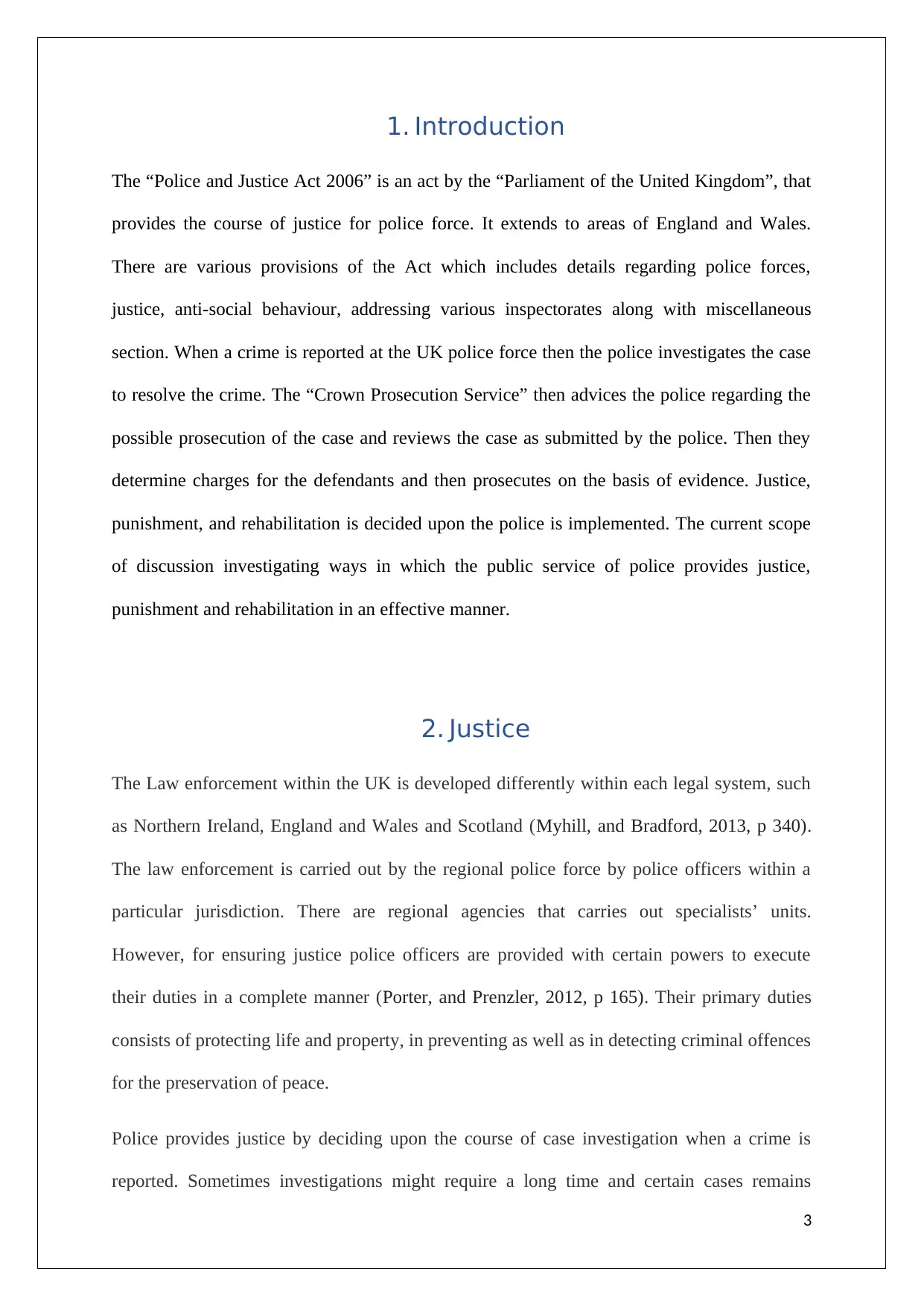
1. Introduction
The “Police and Justice Act 2006” is an act by the “Parliament of the United Kingdom”, that
provides the course of justice for police force. It extends to areas of England and Wales.
There are various provisions of the Act which includes details regarding police forces,
justice, anti-social behaviour, addressing various inspectorates along with miscellaneous
section. When a crime is reported at the UK police force then the police investigates the case
to resolve the crime. The “Crown Prosecution Service” then advices the police regarding the
possible prosecution of the case and reviews the case as submitted by the police. Then they
determine charges for the defendants and then prosecutes on the basis of evidence. Justice,
punishment, and rehabilitation is decided upon the police is implemented. The current scope
of discussion investigating ways in which the public service of police provides justice,
punishment and rehabilitation in an effective manner.
2. Justice
The Law enforcement within the UK is developed differently within each legal system, such
as Northern Ireland, England and Wales and Scotland (Myhill, and Bradford, 2013, p 340).
The law enforcement is carried out by the regional police force by police officers within a
particular jurisdiction. There are regional agencies that carries out specialists’ units.
However, for ensuring justice police officers are provided with certain powers to execute
their duties in a complete manner (Porter, and Prenzler, 2012, p 165). Their primary duties
consists of protecting life and property, in preventing as well as in detecting criminal offences
for the preservation of peace.
Police provides justice by deciding upon the course of case investigation when a crime is
reported. Sometimes investigations might require a long time and certain cases remains
3
The “Police and Justice Act 2006” is an act by the “Parliament of the United Kingdom”, that
provides the course of justice for police force. It extends to areas of England and Wales.
There are various provisions of the Act which includes details regarding police forces,
justice, anti-social behaviour, addressing various inspectorates along with miscellaneous
section. When a crime is reported at the UK police force then the police investigates the case
to resolve the crime. The “Crown Prosecution Service” then advices the police regarding the
possible prosecution of the case and reviews the case as submitted by the police. Then they
determine charges for the defendants and then prosecutes on the basis of evidence. Justice,
punishment, and rehabilitation is decided upon the police is implemented. The current scope
of discussion investigating ways in which the public service of police provides justice,
punishment and rehabilitation in an effective manner.
2. Justice
The Law enforcement within the UK is developed differently within each legal system, such
as Northern Ireland, England and Wales and Scotland (Myhill, and Bradford, 2013, p 340).
The law enforcement is carried out by the regional police force by police officers within a
particular jurisdiction. There are regional agencies that carries out specialists’ units.
However, for ensuring justice police officers are provided with certain powers to execute
their duties in a complete manner (Porter, and Prenzler, 2012, p 165). Their primary duties
consists of protecting life and property, in preventing as well as in detecting criminal offences
for the preservation of peace.
Police provides justice by deciding upon the course of case investigation when a crime is
reported. Sometimes investigations might require a long time and certain cases remains
3
⊘ This is a preview!⊘
Do you want full access?
Subscribe today to unlock all pages.

Trusted by 1+ million students worldwide
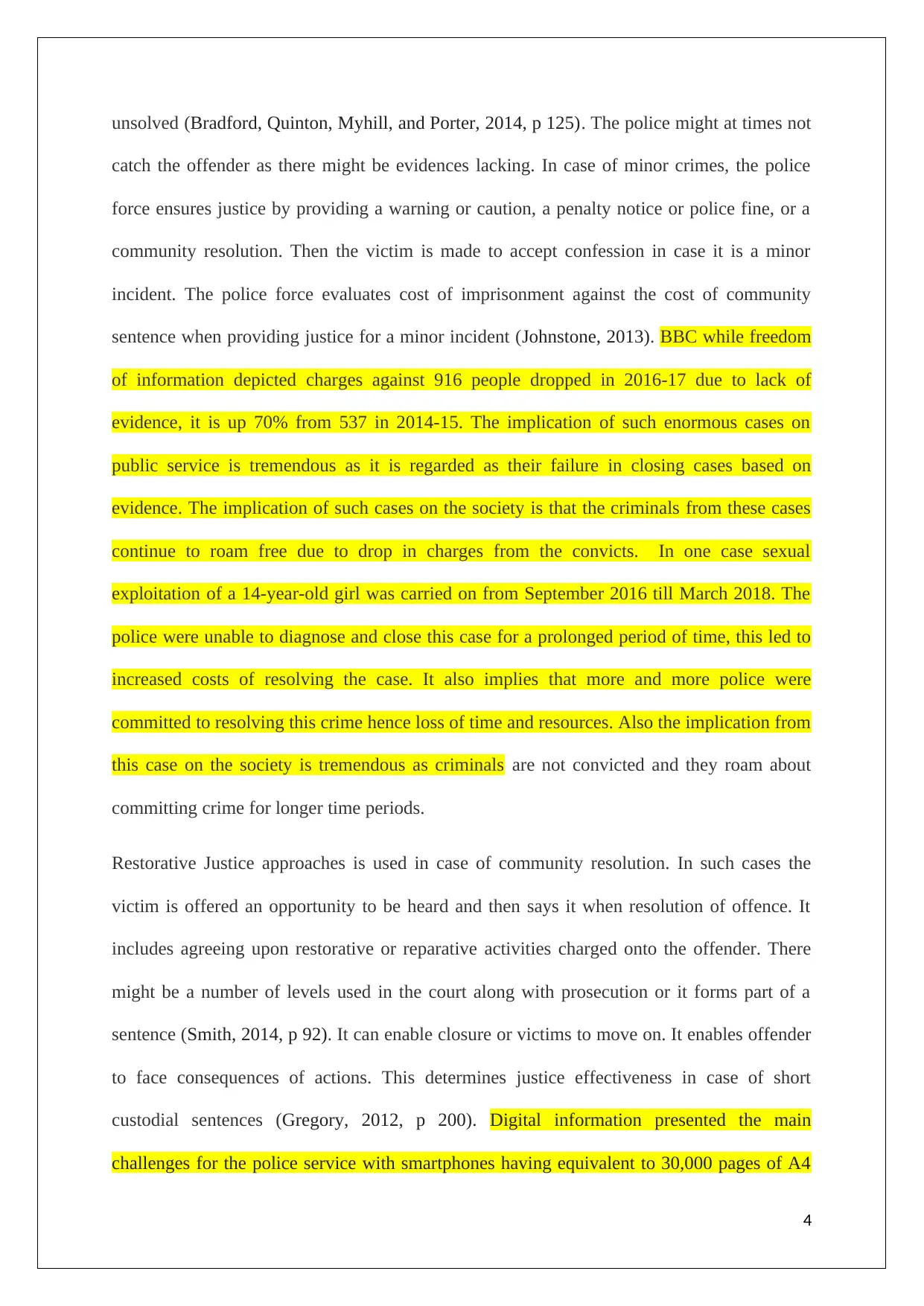
unsolved (Bradford, Quinton, Myhill, and Porter, 2014, p 125). The police might at times not
catch the offender as there might be evidences lacking. In case of minor crimes, the police
force ensures justice by providing a warning or caution, a penalty notice or police fine, or a
community resolution. Then the victim is made to accept confession in case it is a minor
incident. The police force evaluates cost of imprisonment against the cost of community
sentence when providing justice for a minor incident (Johnstone, 2013). BBC while freedom
of information depicted charges against 916 people dropped in 2016-17 due to lack of
evidence, it is up 70% from 537 in 2014-15. The implication of such enormous cases on
public service is tremendous as it is regarded as their failure in closing cases based on
evidence. The implication of such cases on the society is that the criminals from these cases
continue to roam free due to drop in charges from the convicts. In one case sexual
exploitation of a 14-year-old girl was carried on from September 2016 till March 2018. The
police were unable to diagnose and close this case for a prolonged period of time, this led to
increased costs of resolving the case. It also implies that more and more police were
committed to resolving this crime hence loss of time and resources. Also the implication from
this case on the society is tremendous as criminals are not convicted and they roam about
committing crime for longer time periods.
Restorative Justice approaches is used in case of community resolution. In such cases the
victim is offered an opportunity to be heard and then says it when resolution of offence. It
includes agreeing upon restorative or reparative activities charged onto the offender. There
might be a number of levels used in the court along with prosecution or it forms part of a
sentence (Smith, 2014, p 92). It can enable closure or victims to move on. It enables offender
to face consequences of actions. This determines justice effectiveness in case of short
custodial sentences (Gregory, 2012, p 200). Digital information presented the main
challenges for the police service with smartphones having equivalent to 30,000 pages of A4
4
catch the offender as there might be evidences lacking. In case of minor crimes, the police
force ensures justice by providing a warning or caution, a penalty notice or police fine, or a
community resolution. Then the victim is made to accept confession in case it is a minor
incident. The police force evaluates cost of imprisonment against the cost of community
sentence when providing justice for a minor incident (Johnstone, 2013). BBC while freedom
of information depicted charges against 916 people dropped in 2016-17 due to lack of
evidence, it is up 70% from 537 in 2014-15. The implication of such enormous cases on
public service is tremendous as it is regarded as their failure in closing cases based on
evidence. The implication of such cases on the society is that the criminals from these cases
continue to roam free due to drop in charges from the convicts. In one case sexual
exploitation of a 14-year-old girl was carried on from September 2016 till March 2018. The
police were unable to diagnose and close this case for a prolonged period of time, this led to
increased costs of resolving the case. It also implies that more and more police were
committed to resolving this crime hence loss of time and resources. Also the implication from
this case on the society is tremendous as criminals are not convicted and they roam about
committing crime for longer time periods.
Restorative Justice approaches is used in case of community resolution. In such cases the
victim is offered an opportunity to be heard and then says it when resolution of offence. It
includes agreeing upon restorative or reparative activities charged onto the offender. There
might be a number of levels used in the court along with prosecution or it forms part of a
sentence (Smith, 2014, p 92). It can enable closure or victims to move on. It enables offender
to face consequences of actions. This determines justice effectiveness in case of short
custodial sentences (Gregory, 2012, p 200). Digital information presented the main
challenges for the police service with smartphones having equivalent to 30,000 pages of A4
4
Paraphrase This Document
Need a fresh take? Get an instant paraphrase of this document with our AI Paraphraser
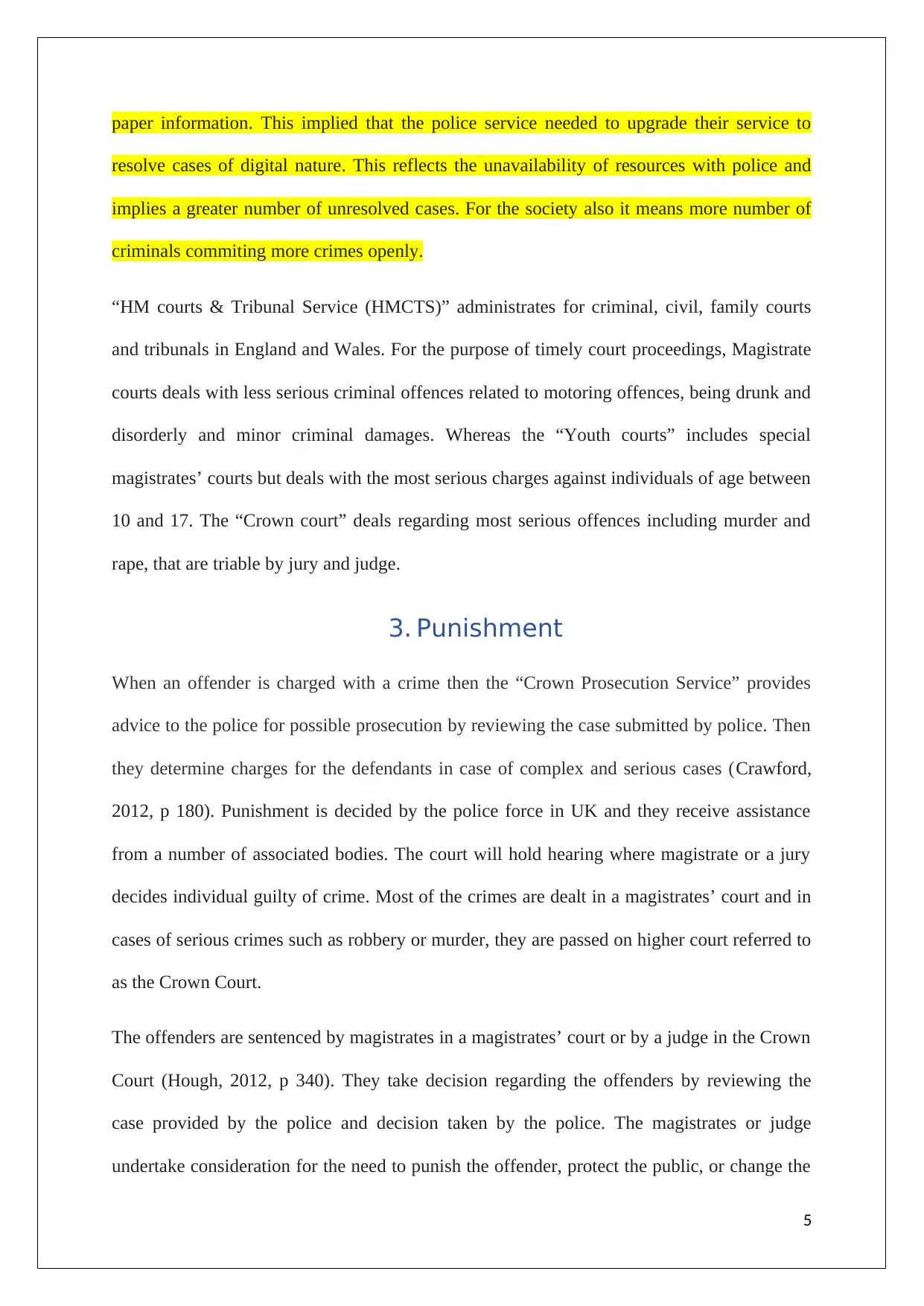
paper information. This implied that the police service needed to upgrade their service to
resolve cases of digital nature. This reflects the unavailability of resources with police and
implies a greater number of unresolved cases. For the society also it means more number of
criminals commiting more crimes openly.
“HM courts & Tribunal Service (HMCTS)” administrates for criminal, civil, family courts
and tribunals in England and Wales. For the purpose of timely court proceedings, Magistrate
courts deals with less serious criminal offences related to motoring offences, being drunk and
disorderly and minor criminal damages. Whereas the “Youth courts” includes special
magistrates’ courts but deals with the most serious charges against individuals of age between
10 and 17. The “Crown court” deals regarding most serious offences including murder and
rape, that are triable by jury and judge.
3. Punishment
When an offender is charged with a crime then the “Crown Prosecution Service” provides
advice to the police for possible prosecution by reviewing the case submitted by police. Then
they determine charges for the defendants in case of complex and serious cases (Crawford,
2012, p 180). Punishment is decided by the police force in UK and they receive assistance
from a number of associated bodies. The court will hold hearing where magistrate or a jury
decides individual guilty of crime. Most of the crimes are dealt in a magistrates’ court and in
cases of serious crimes such as robbery or murder, they are passed on higher court referred to
as the Crown Court.
The offenders are sentenced by magistrates in a magistrates’ court or by a judge in the Crown
Court (Hough, 2012, p 340). They take decision regarding the offenders by reviewing the
case provided by the police and decision taken by the police. The magistrates or judge
undertake consideration for the need to punish the offender, protect the public, or change the
5
resolve cases of digital nature. This reflects the unavailability of resources with police and
implies a greater number of unresolved cases. For the society also it means more number of
criminals commiting more crimes openly.
“HM courts & Tribunal Service (HMCTS)” administrates for criminal, civil, family courts
and tribunals in England and Wales. For the purpose of timely court proceedings, Magistrate
courts deals with less serious criminal offences related to motoring offences, being drunk and
disorderly and minor criminal damages. Whereas the “Youth courts” includes special
magistrates’ courts but deals with the most serious charges against individuals of age between
10 and 17. The “Crown court” deals regarding most serious offences including murder and
rape, that are triable by jury and judge.
3. Punishment
When an offender is charged with a crime then the “Crown Prosecution Service” provides
advice to the police for possible prosecution by reviewing the case submitted by police. Then
they determine charges for the defendants in case of complex and serious cases (Crawford,
2012, p 180). Punishment is decided by the police force in UK and they receive assistance
from a number of associated bodies. The court will hold hearing where magistrate or a jury
decides individual guilty of crime. Most of the crimes are dealt in a magistrates’ court and in
cases of serious crimes such as robbery or murder, they are passed on higher court referred to
as the Crown Court.
The offenders are sentenced by magistrates in a magistrates’ court or by a judge in the Crown
Court (Hough, 2012, p 340). They take decision regarding the offenders by reviewing the
case provided by the police and decision taken by the police. The magistrates or judge
undertake consideration for the need to punish the offender, protect the public, or change the
5
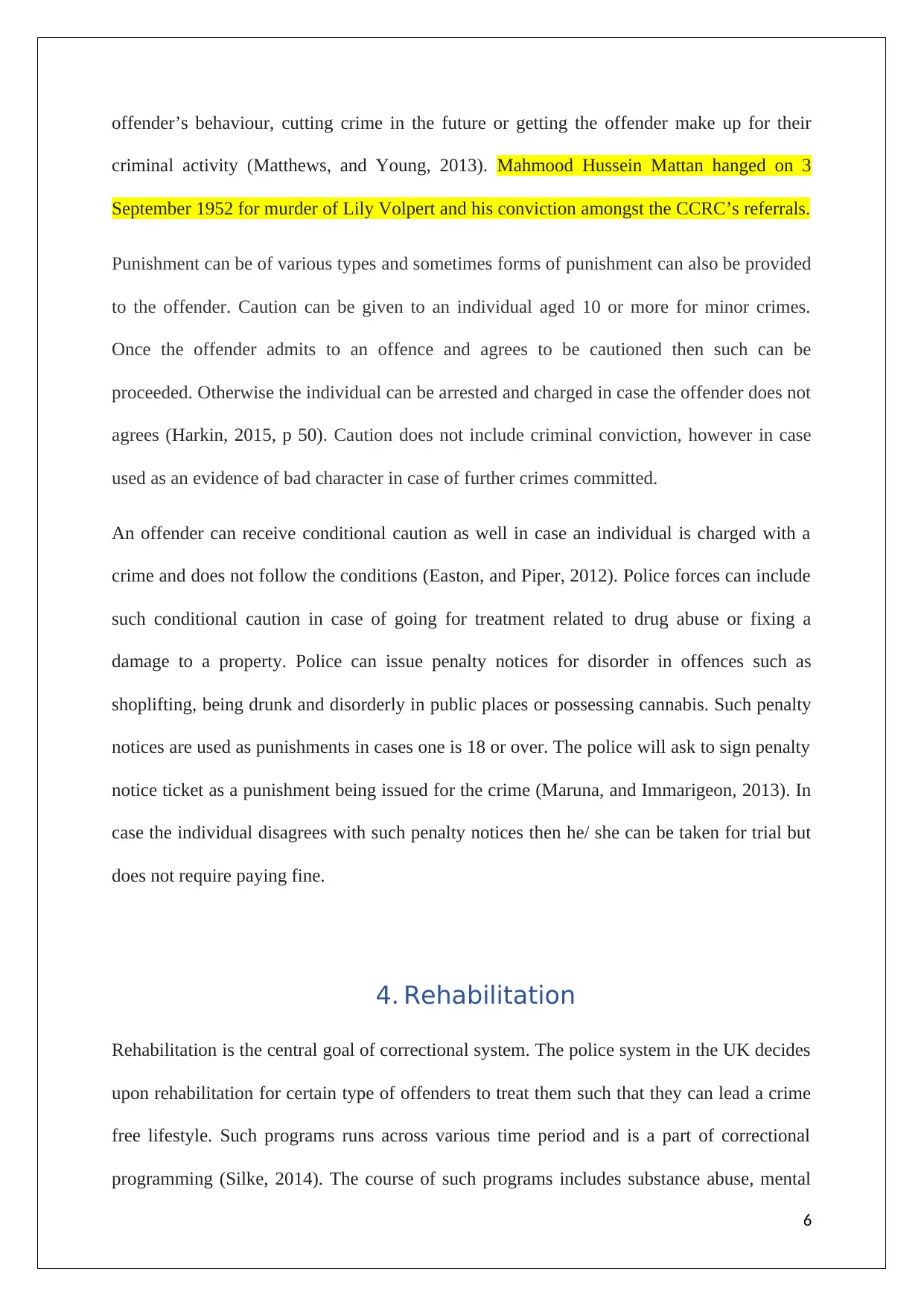
offender’s behaviour, cutting crime in the future or getting the offender make up for their
criminal activity (Matthews, and Young, 2013). Mahmood Hussein Mattan hanged on 3
September 1952 for murder of Lily Volpert and his conviction amongst the CCRC’s referrals.
Punishment can be of various types and sometimes forms of punishment can also be provided
to the offender. Caution can be given to an individual aged 10 or more for minor crimes.
Once the offender admits to an offence and agrees to be cautioned then such can be
proceeded. Otherwise the individual can be arrested and charged in case the offender does not
agrees (Harkin, 2015, p 50). Caution does not include criminal conviction, however in case
used as an evidence of bad character in case of further crimes committed.
An offender can receive conditional caution as well in case an individual is charged with a
crime and does not follow the conditions (Easton, and Piper, 2012). Police forces can include
such conditional caution in case of going for treatment related to drug abuse or fixing a
damage to a property. Police can issue penalty notices for disorder in offences such as
shoplifting, being drunk and disorderly in public places or possessing cannabis. Such penalty
notices are used as punishments in cases one is 18 or over. The police will ask to sign penalty
notice ticket as a punishment being issued for the crime (Maruna, and Immarigeon, 2013). In
case the individual disagrees with such penalty notices then he/ she can be taken for trial but
does not require paying fine.
4. Rehabilitation
Rehabilitation is the central goal of correctional system. The police system in the UK decides
upon rehabilitation for certain type of offenders to treat them such that they can lead a crime
free lifestyle. Such programs runs across various time period and is a part of correctional
programming (Silke, 2014). The course of such programs includes substance abuse, mental
6
criminal activity (Matthews, and Young, 2013). Mahmood Hussein Mattan hanged on 3
September 1952 for murder of Lily Volpert and his conviction amongst the CCRC’s referrals.
Punishment can be of various types and sometimes forms of punishment can also be provided
to the offender. Caution can be given to an individual aged 10 or more for minor crimes.
Once the offender admits to an offence and agrees to be cautioned then such can be
proceeded. Otherwise the individual can be arrested and charged in case the offender does not
agrees (Harkin, 2015, p 50). Caution does not include criminal conviction, however in case
used as an evidence of bad character in case of further crimes committed.
An offender can receive conditional caution as well in case an individual is charged with a
crime and does not follow the conditions (Easton, and Piper, 2012). Police forces can include
such conditional caution in case of going for treatment related to drug abuse or fixing a
damage to a property. Police can issue penalty notices for disorder in offences such as
shoplifting, being drunk and disorderly in public places or possessing cannabis. Such penalty
notices are used as punishments in cases one is 18 or over. The police will ask to sign penalty
notice ticket as a punishment being issued for the crime (Maruna, and Immarigeon, 2013). In
case the individual disagrees with such penalty notices then he/ she can be taken for trial but
does not require paying fine.
4. Rehabilitation
Rehabilitation is the central goal of correctional system. The police system in the UK decides
upon rehabilitation for certain type of offenders to treat them such that they can lead a crime
free lifestyle. Such programs runs across various time period and is a part of correctional
programming (Silke, 2014). The course of such programs includes substance abuse, mental
6
⊘ This is a preview!⊘
Do you want full access?
Subscribe today to unlock all pages.

Trusted by 1+ million students worldwide
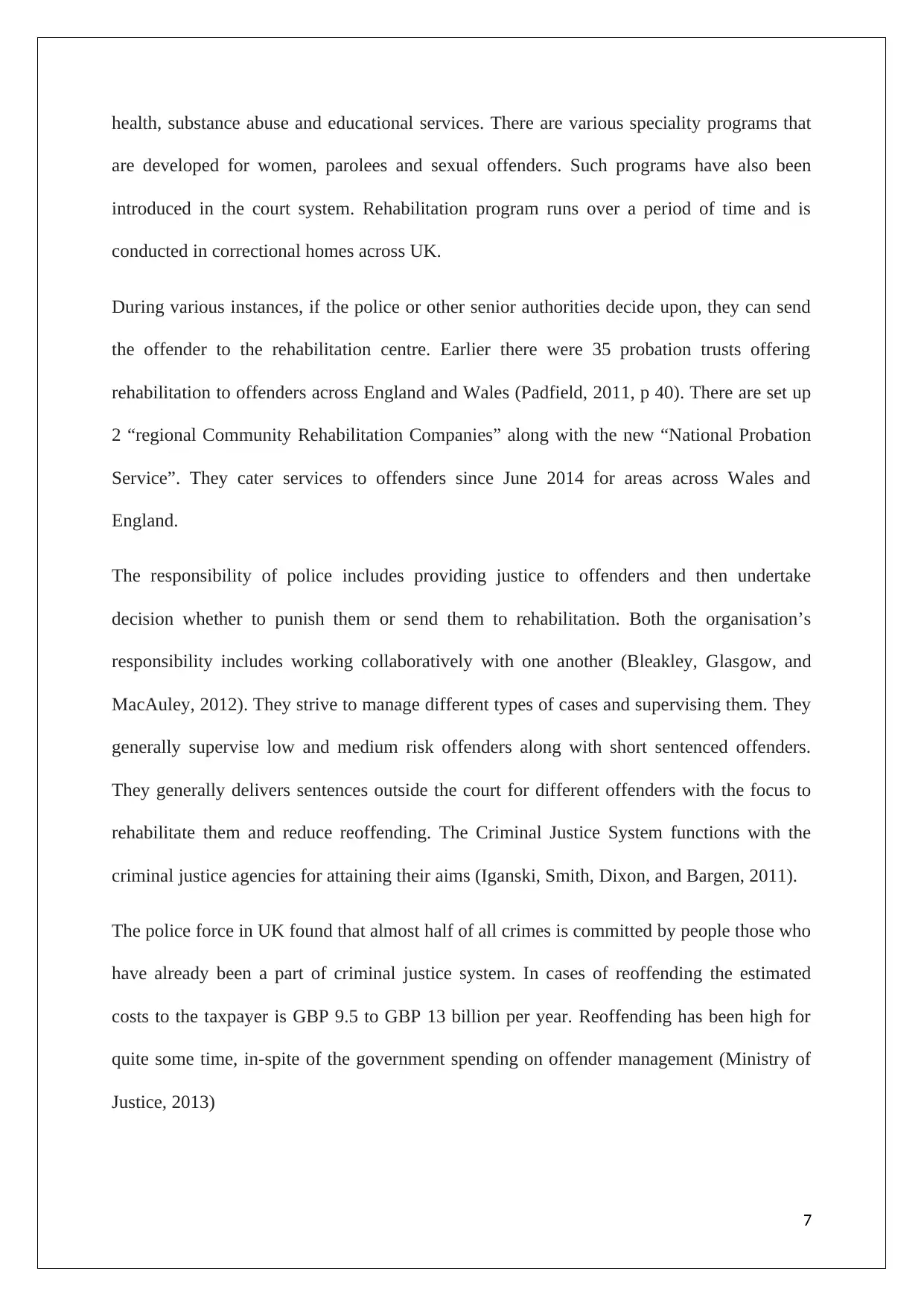
health, substance abuse and educational services. There are various speciality programs that
are developed for women, parolees and sexual offenders. Such programs have also been
introduced in the court system. Rehabilitation program runs over a period of time and is
conducted in correctional homes across UK.
During various instances, if the police or other senior authorities decide upon, they can send
the offender to the rehabilitation centre. Earlier there were 35 probation trusts offering
rehabilitation to offenders across England and Wales (Padfield, 2011, p 40). There are set up
2 “regional Community Rehabilitation Companies” along with the new “National Probation
Service”. They cater services to offenders since June 2014 for areas across Wales and
England.
The responsibility of police includes providing justice to offenders and then undertake
decision whether to punish them or send them to rehabilitation. Both the organisation’s
responsibility includes working collaboratively with one another (Bleakley, Glasgow, and
MacAuley, 2012). They strive to manage different types of cases and supervising them. They
generally supervise low and medium risk offenders along with short sentenced offenders.
They generally delivers sentences outside the court for different offenders with the focus to
rehabilitate them and reduce reoffending. The Criminal Justice System functions with the
criminal justice agencies for attaining their aims (Iganski, Smith, Dixon, and Bargen, 2011).
The police force in UK found that almost half of all crimes is committed by people those who
have already been a part of criminal justice system. In cases of reoffending the estimated
costs to the taxpayer is GBP 9.5 to GBP 13 billion per year. Reoffending has been high for
quite some time, in-spite of the government spending on offender management (Ministry of
Justice, 2013)
7
are developed for women, parolees and sexual offenders. Such programs have also been
introduced in the court system. Rehabilitation program runs over a period of time and is
conducted in correctional homes across UK.
During various instances, if the police or other senior authorities decide upon, they can send
the offender to the rehabilitation centre. Earlier there were 35 probation trusts offering
rehabilitation to offenders across England and Wales (Padfield, 2011, p 40). There are set up
2 “regional Community Rehabilitation Companies” along with the new “National Probation
Service”. They cater services to offenders since June 2014 for areas across Wales and
England.
The responsibility of police includes providing justice to offenders and then undertake
decision whether to punish them or send them to rehabilitation. Both the organisation’s
responsibility includes working collaboratively with one another (Bleakley, Glasgow, and
MacAuley, 2012). They strive to manage different types of cases and supervising them. They
generally supervise low and medium risk offenders along with short sentenced offenders.
They generally delivers sentences outside the court for different offenders with the focus to
rehabilitate them and reduce reoffending. The Criminal Justice System functions with the
criminal justice agencies for attaining their aims (Iganski, Smith, Dixon, and Bargen, 2011).
The police force in UK found that almost half of all crimes is committed by people those who
have already been a part of criminal justice system. In cases of reoffending the estimated
costs to the taxpayer is GBP 9.5 to GBP 13 billion per year. Reoffending has been high for
quite some time, in-spite of the government spending on offender management (Ministry of
Justice, 2013)
7
Paraphrase This Document
Need a fresh take? Get an instant paraphrase of this document with our AI Paraphraser
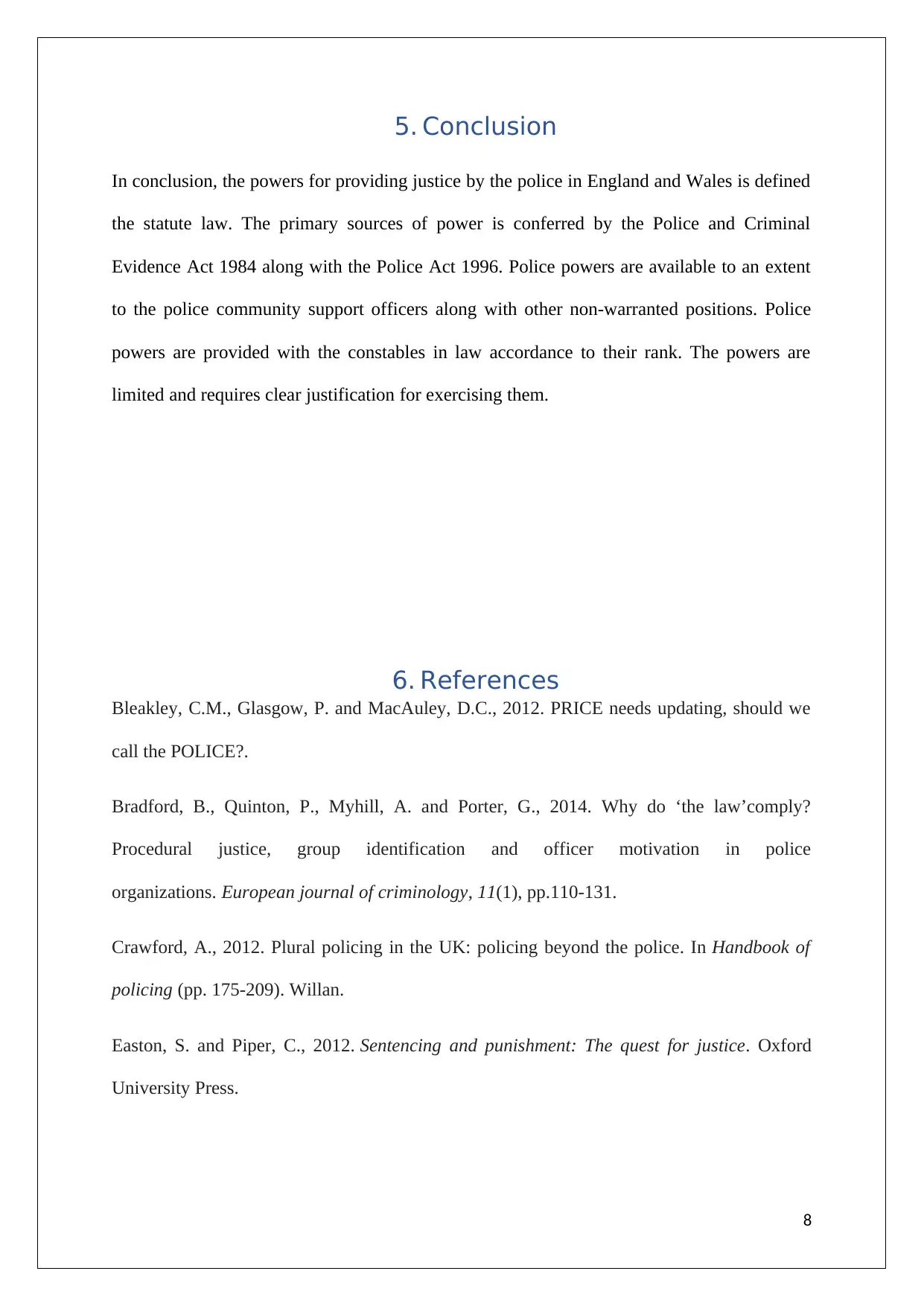
5. Conclusion
In conclusion, the powers for providing justice by the police in England and Wales is defined
the statute law. The primary sources of power is conferred by the Police and Criminal
Evidence Act 1984 along with the Police Act 1996. Police powers are available to an extent
to the police community support officers along with other non-warranted positions. Police
powers are provided with the constables in law accordance to their rank. The powers are
limited and requires clear justification for exercising them.
6. References
Bleakley, C.M., Glasgow, P. and MacAuley, D.C., 2012. PRICE needs updating, should we
call the POLICE?.
Bradford, B., Quinton, P., Myhill, A. and Porter, G., 2014. Why do ‘the law’comply?
Procedural justice, group identification and officer motivation in police
organizations. European journal of criminology, 11(1), pp.110-131.
Crawford, A., 2012. Plural policing in the UK: policing beyond the police. In Handbook of
policing (pp. 175-209). Willan.
Easton, S. and Piper, C., 2012. Sentencing and punishment: The quest for justice. Oxford
University Press.
8
In conclusion, the powers for providing justice by the police in England and Wales is defined
the statute law. The primary sources of power is conferred by the Police and Criminal
Evidence Act 1984 along with the Police Act 1996. Police powers are available to an extent
to the police community support officers along with other non-warranted positions. Police
powers are provided with the constables in law accordance to their rank. The powers are
limited and requires clear justification for exercising them.
6. References
Bleakley, C.M., Glasgow, P. and MacAuley, D.C., 2012. PRICE needs updating, should we
call the POLICE?.
Bradford, B., Quinton, P., Myhill, A. and Porter, G., 2014. Why do ‘the law’comply?
Procedural justice, group identification and officer motivation in police
organizations. European journal of criminology, 11(1), pp.110-131.
Crawford, A., 2012. Plural policing in the UK: policing beyond the police. In Handbook of
policing (pp. 175-209). Willan.
Easton, S. and Piper, C., 2012. Sentencing and punishment: The quest for justice. Oxford
University Press.
8
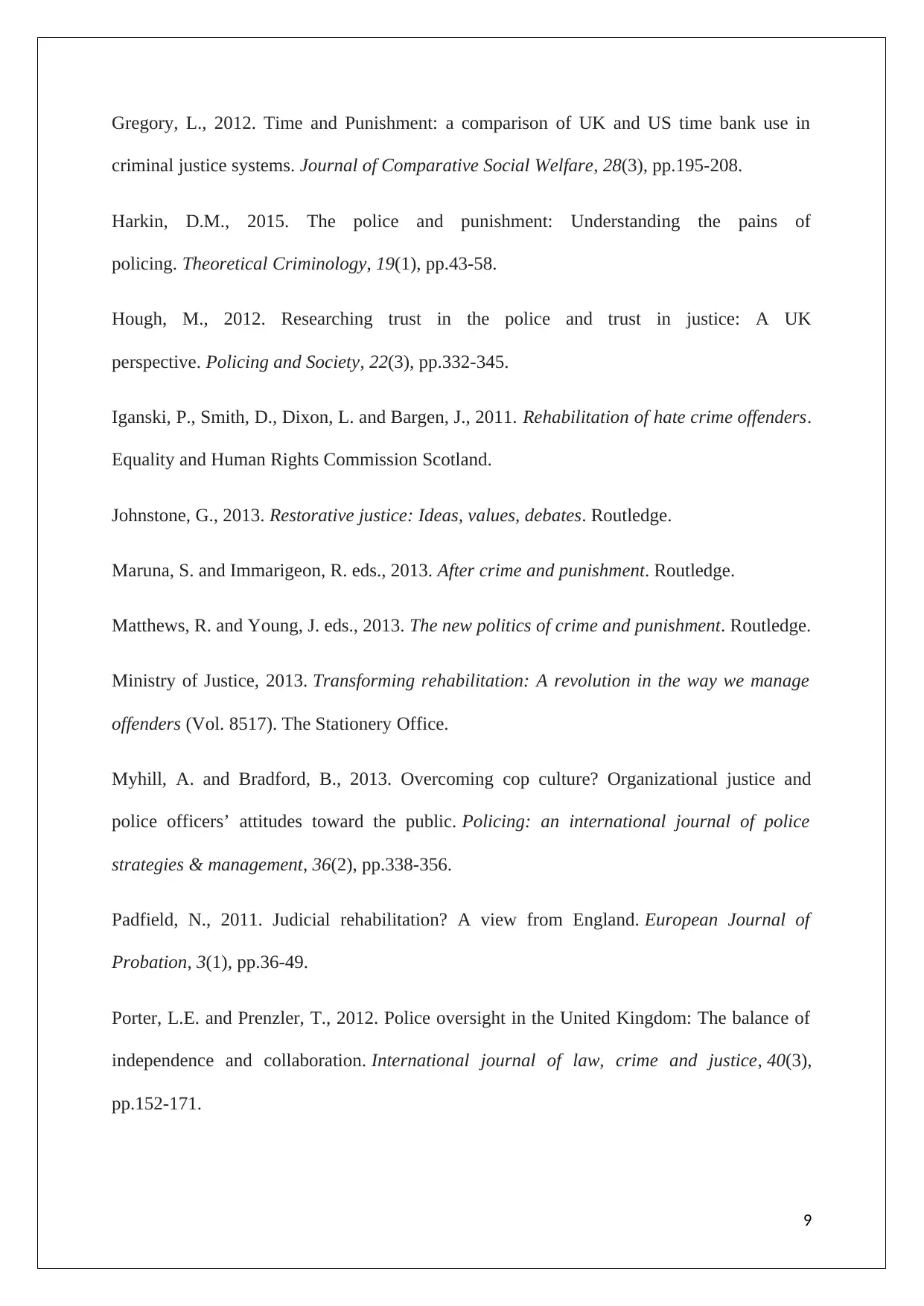
Gregory, L., 2012. Time and Punishment: a comparison of UK and US time bank use in
criminal justice systems. Journal of Comparative Social Welfare, 28(3), pp.195-208.
Harkin, D.M., 2015. The police and punishment: Understanding the pains of
policing. Theoretical Criminology, 19(1), pp.43-58.
Hough, M., 2012. Researching trust in the police and trust in justice: A UK
perspective. Policing and Society, 22(3), pp.332-345.
Iganski, P., Smith, D., Dixon, L. and Bargen, J., 2011. Rehabilitation of hate crime offenders.
Equality and Human Rights Commission Scotland.
Johnstone, G., 2013. Restorative justice: Ideas, values, debates. Routledge.
Maruna, S. and Immarigeon, R. eds., 2013. After crime and punishment. Routledge.
Matthews, R. and Young, J. eds., 2013. The new politics of crime and punishment. Routledge.
Ministry of Justice, 2013. Transforming rehabilitation: A revolution in the way we manage
offenders (Vol. 8517). The Stationery Office.
Myhill, A. and Bradford, B., 2013. Overcoming cop culture? Organizational justice and
police officers’ attitudes toward the public. Policing: an international journal of police
strategies & management, 36(2), pp.338-356.
Padfield, N., 2011. Judicial rehabilitation? A view from England. European Journal of
Probation, 3(1), pp.36-49.
Porter, L.E. and Prenzler, T., 2012. Police oversight in the United Kingdom: The balance of
independence and collaboration. International journal of law, crime and justice, 40(3),
pp.152-171.
9
criminal justice systems. Journal of Comparative Social Welfare, 28(3), pp.195-208.
Harkin, D.M., 2015. The police and punishment: Understanding the pains of
policing. Theoretical Criminology, 19(1), pp.43-58.
Hough, M., 2012. Researching trust in the police and trust in justice: A UK
perspective. Policing and Society, 22(3), pp.332-345.
Iganski, P., Smith, D., Dixon, L. and Bargen, J., 2011. Rehabilitation of hate crime offenders.
Equality and Human Rights Commission Scotland.
Johnstone, G., 2013. Restorative justice: Ideas, values, debates. Routledge.
Maruna, S. and Immarigeon, R. eds., 2013. After crime and punishment. Routledge.
Matthews, R. and Young, J. eds., 2013. The new politics of crime and punishment. Routledge.
Ministry of Justice, 2013. Transforming rehabilitation: A revolution in the way we manage
offenders (Vol. 8517). The Stationery Office.
Myhill, A. and Bradford, B., 2013. Overcoming cop culture? Organizational justice and
police officers’ attitudes toward the public. Policing: an international journal of police
strategies & management, 36(2), pp.338-356.
Padfield, N., 2011. Judicial rehabilitation? A view from England. European Journal of
Probation, 3(1), pp.36-49.
Porter, L.E. and Prenzler, T., 2012. Police oversight in the United Kingdom: The balance of
independence and collaboration. International journal of law, crime and justice, 40(3),
pp.152-171.
9
⊘ This is a preview!⊘
Do you want full access?
Subscribe today to unlock all pages.

Trusted by 1+ million students worldwide

Silke, A. ed., 2014. Prisons, terrorism and extremism: Critical issues in management,
radicalisation and reform. Routledge.
Smith, A.M., 2014. Police. uk and Data. police. uk: Developing Open Crime and Justice Data
for the UK. JeDEM-eJournal of eDemocracy and Open Government, 6(1), pp.87-96.
10
radicalisation and reform. Routledge.
Smith, A.M., 2014. Police. uk and Data. police. uk: Developing Open Crime and Justice Data
for the UK. JeDEM-eJournal of eDemocracy and Open Government, 6(1), pp.87-96.
10
1 out of 10
Related Documents
Your All-in-One AI-Powered Toolkit for Academic Success.
+13062052269
info@desklib.com
Available 24*7 on WhatsApp / Email
![[object Object]](/_next/static/media/star-bottom.7253800d.svg)
Unlock your academic potential
Copyright © 2020–2025 A2Z Services. All Rights Reserved. Developed and managed by ZUCOL.




